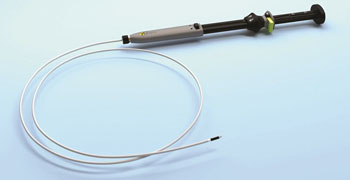Innovative System Helps Treat Serious Pancreatitis Complications
By HospiMedica International staff writers
Posted on 06 Apr 2016
A novel stent and delivery system aids the endoscopic management of pancreatic pseudocysts and certain types of walled-off pancreatic necrosis. Posted on 06 Apr 2016
The AXIOS stent and electrocautery enhanced delivery system is designed to form a temporary anastomotic conduit between the diseased areas of the pancreas and the gastrointestinal (GI) tract. Using endoscopic ultrasound (EUS) guidance, the stent is delivered to adjacent to the pseudocyst pancreatic fluid collections (PFCs) site. After the GI wall has been breached, the stent is used as a translumenal conduit to bridge the intervening tissues into the pseudocyst, draining it directly into the stomach. Once the pseudocyst has drained and decreased in size, the stent is removed.

Image: The AXIOS Stent and Electrocautery Enhanced Delivery System (Photo courtesy of Boston Scientific).
The stent comes pre-loaded in the delivery system and is available in multiple lumen diameters (15 mm, 10 mm, 8 mm, and 6 mm) and lengths (10 mm, 6 mm, and 4 mm) to ensure a custom fit. Two large flanges hold the tissue layers together and form a large diameter drainage channel. The stent is fully covered to prevent leakage and to enable easy removal. The Axios stent and delivery system is a product of Boston Scientific Corporation (Natick, MA, USA), and is magnetic resonance imaging (MRI) compatible.
“In our practice, the AXIOS System has improved the endoscopic treatment of PFCs and walled off necrosis. The delivery system has improved our procedural efficiency by reducing procedure time and patient exposure to X-ray imaging,” said Prof. Todd Baron, MD, director of advanced therapeutic endoscopy at the University of North Carolina Hospital (Chapel Hill, USA). “In addition, we believe that the large diameter stent design is helping to reduce the cost of care by decreasing hospital length of stay and the number of interventions needed to manage this complex disease.”
Pancreatic ducts may become blocked due to gallstones or injury, causing enzymes that normally drain into the small intestine to be released directly into the pancreas, which can cause a pseudocyst PFCs to form. Open surgery for treating PFCs has been associated with high rates of morbidity and mortality, but endoscopic solutions can offer a less invasive treatment option associated with shorter hospital stays, better physical and mental health of patients, and lower cost.
Related Links:
Boston Scientific Corporation














